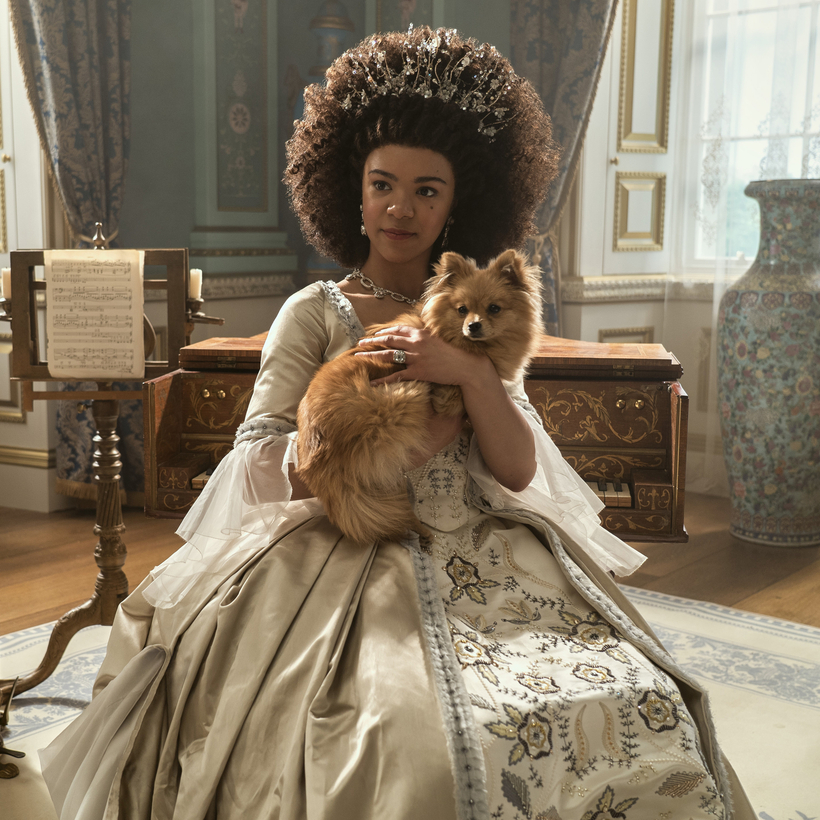While residents of England will toast the crowning of His Majesty King Charles III this weekend, Bridgerton fans are celebrating a coronation of their own. In Shonda Rhimes’s latest historical drama, Queen Charlotte: A Bridgerton Story, the Queen and her husband, King George III, take the throne. The show serves as a prequel to Rhimes’s acclaimed Bridgerton series, which is known for its slow-burn romances and its reimagining of the Regency era with people of color included in the British ton and royal family.
A few important details that distinguish this week’s royal stars: King Charles of the House of Windsor is a 74-year-old white male whose acting career ended once he graduated from Cambridge University. India Ria Amarteifio, on the other hand, is a 21-year-old bi-racial actress from Twickenham who has been acting since her West End debut, when she was just 11 years old.
In Queen Charlotte, which is streaming on Netflix, Amarteifio portrays the titular character. Rhimes’s fictitious retelling of English history sees Queen Charlotte as a Black trailblazer for race integration in British high society. She leads by example, marrying King George III of Britain, who, like King Charles III, is a white man.

“I didn’t have to search too far to know what it feels like to try and fit into different societies that don’t necessarily accept you with open arms,” says Amarteifio. “I grew up in a very Caucasian community. I’m very close to my mom’s side of the family, who are white, so my experience with finding my Blackness and what that means to me is an ongoing journey and one that I’m able to use in this job.”
The series does not shy away from depicting racism, and Queen Charlotte often finds herself standing up for the Black community within British high society. See, for example, a scene in which the Queen gets her wedding portrait done. The artist insists on painting her skin in a lighter tone, per the request of Charlotte’s mother-in-law, Princess Augusta. Queen Charlotte pushes back. “My skin is too light,” she says indignantly. “Paint my skin darker, as it actually is.”
“My experience with finding my Blackness and what that means to me is an ongoing journey and one that I’m able to use in this job.”
Amarteifio explains that the racism Queen Charlotte faces and resists, especially the pressure to abide by Eurocentric beauty standards, is very similar to what she dealt with growing up in the U.K.
“I never really saw myself as beautiful, and then I had this job,” she says. “I’m understanding that beauty is not one thing. I don’t need to try and conform to whatever I’ve been sold.”
It’s difficult not to notice the parallels between Queen Charlotte’s growing confidence as the show progresses and Amarteifio’s growing confidence since she stepped into the role. Playing the Queen “made me more of an emotional person, in [a] better sense,” she explains. “I always felt too shy to be emotional … but in this job I’ve had to access every single feeling, from complete elation to absolute despair.”
When it came to tapping into a range of difficult emotions to play Charlotte, Amarteifio admits that some feelings came more naturally than others. Fortunately for Bridgerton fans, who revel in the palpable chemistry between the main characters, Amarteifio’s fondness for and appreciation of her co-star and on-screen love interest, Corey Mylchreest, is clearly authentic.
“Me and Corey have this thing we say to each other: ‘So glad it’s you,’” Amarteifio tells me. “In the sense of: Thank God we are able to just be ourselves with each other and kind of go through this crazy journey together.”

Mylchreest plays King George III, who, both historically and in the series, is known for being devoted to his Queen, while also battling bouts of mania and depression. Charlotte cares for him and loves him through the hardships.
“We put a lot of time into that relationship,” she says. “We would sit for maybe three or four hours after shooting every single night in preparation for the next scene.”
Staying up late to run lines and waking up as early as four a.m. to start filming, Amarteifio sometimes wondered, especially when she was hungry and sleep-deprived, why she was putting herself through such a rigorous project.
“This job means so much more than myself, and that’s what gave me the motivation to get up at stupid o’clock in the morning,” she says. “I’m giving [Black brits] a voice, and I’m giving them a reference.... I’m giving them basically what I should have had at 14 or 15 years old.”
Queen Charlotte: A Bridgerton Story is available for streaming on Netflix
Carolina de Armas is an Associate Editor for AIR MAIL

